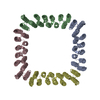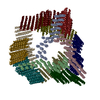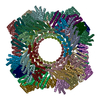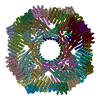+Search query
-Structure paper
| Title | Blueprinting extendable nanomaterials with standardized protein blocks. |
|---|---|
| Journal, issue, pages | Nature, Vol. 627, Issue 8005, Page 898-904, Year 2024 |
| Publish date | Mar 13, 2024 |
 Authors Authors | Timothy F Huddy / Yang Hsia / Ryan D Kibler / Jinwei Xu / Neville Bethel / Deepesh Nagarajan / Rachel Redler / Philip J Y Leung / Connor Weidle / Alexis Courbet / Erin C Yang / Asim K Bera / Nicolas Coudray / S John Calise / Fatima A Davila-Hernandez / Hannah L Han / Kenneth D Carr / Zhe Li / Ryan McHugh / Gabriella Reggiano / Alex Kang / Banumathi Sankaran / Miles S Dickinson / Brian Coventry / T J Brunette / Yulai Liu / Justas Dauparas / Andrew J Borst / Damian Ekiert / Justin M Kollman / Gira Bhabha / David Baker /   |
| PubMed Abstract | A wooden house frame consists of many different lumber pieces, but because of the regularity of these building blocks, the structure can be designed using straightforward geometrical principles. The ...A wooden house frame consists of many different lumber pieces, but because of the regularity of these building blocks, the structure can be designed using straightforward geometrical principles. The design of multicomponent protein assemblies, in comparison, has been much more complex, largely owing to the irregular shapes of protein structures. Here we describe extendable linear, curved and angled protein building blocks, as well as inter-block interactions, that conform to specified geometric standards; assemblies designed using these blocks inherit their extendability and regular interaction surfaces, enabling them to be expanded or contracted by varying the number of modules, and reinforced with secondary struts. Using X-ray crystallography and electron microscopy, we validate nanomaterial designs ranging from simple polygonal and circular oligomers that can be concentrically nested, up to large polyhedral nanocages and unbounded straight 'train track' assemblies with reconfigurable sizes and geometries that can be readily blueprinted. Because of the complexity of protein structures and sequence-structure relationships, it has not previously been possible to build up large protein assemblies by deliberate placement of protein backbones onto a blank three-dimensional canvas; the simplicity and geometric regularity of our design platform now enables construction of protein nanomaterials according to 'back of an envelope' architectural blueprints. |
 External links External links |  Nature / Nature /  PubMed:38480887 / PubMed:38480887 /  PubMed Central PubMed Central |
| Methods | EM (single particle) / X-ray diffraction |
| Resolution | 2.48 - 12.98 Å |
| Structure data | EMDB-29974, PDB-8gel:  EMDB-40070: Cryo-EM map of synthetic cage_O3_10 reconstructed without symmetry (C1)  EMDB-40071: Cryo-EM map of synthetic cage_O3_10 reconstructed with O symmetry  EMDB-40073: Cryo-EM map of synthetic cage_T3_5 reconstructed without symmetry (C1), with 1 monomer missing (class 3.0)  EMDB-40074: Cryo-EM map of synthetic cage_T3_5 reconstructed with T symmetry  EMDB-40075: Cryo-EM map of synthetic cage_T3_5 reconstructed without symmetry (C1)  EMDB-40076: Cryo-EM map of synthetic cage_T3_5+2 reconstructed without symmetry (C1) EMDB-41364, PDB-8tl7:  EMDB-41907: Computationally Designed, Expandable O4 Octahedral Handshake Nanocage  EMDB-42031: Computational Designed Nanocage O43_129_+8 EMDB-42906, PDB-8v2d: EMDB-42944, PDB-8v3b:  EMDB-43318: Twistless helix 12 repeat ring design R12B 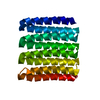 PDB-8g9j: 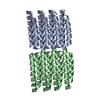 PDB-8g9k:  PDB-8ga6: 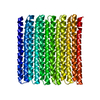 PDB-8ga7: |
| Chemicals |  ChemComp-HOH: |
| Source |
|
 Keywords Keywords |  DE NOVO PROTEIN / DE NOVO PROTEIN /  nanomaterial / protein building blocks / De novo design / train-track / synthetic / nanomaterial / protein building blocks / De novo design / train-track / synthetic /  tetramer / self-assembling / expandable nanomaterial / tetramer / self-assembling / expandable nanomaterial /  de novo / t3 tetrahedral nanocage / computationally designed / de novo / t3 tetrahedral nanocage / computationally designed /  nanocage / expandable nanomaterials / O43_129 / extendable nanomaterials / O43 / Programmable Design nanocage / expandable nanomaterials / O43_129 / extendable nanomaterials / O43 / Programmable Design |
 Movie
Movie Controller
Controller Structure viewers
Structure viewers About Yorodumi Papers
About Yorodumi Papers




